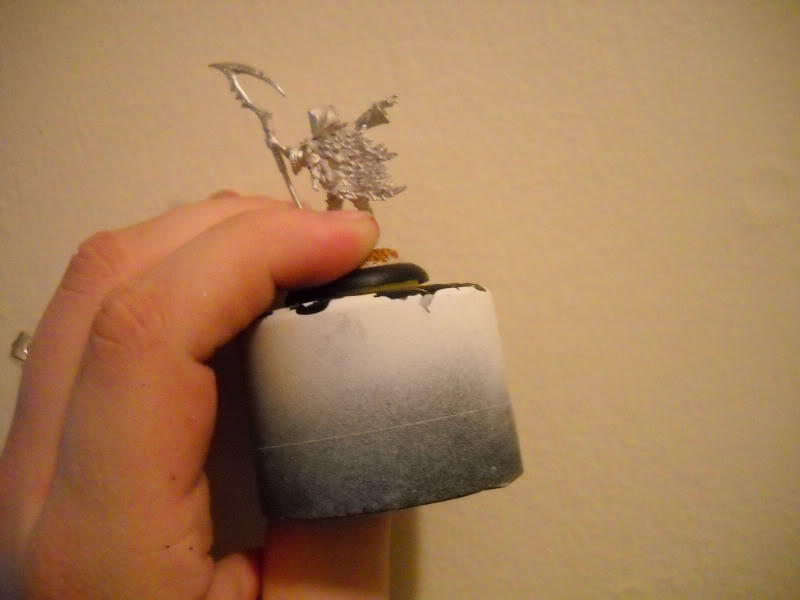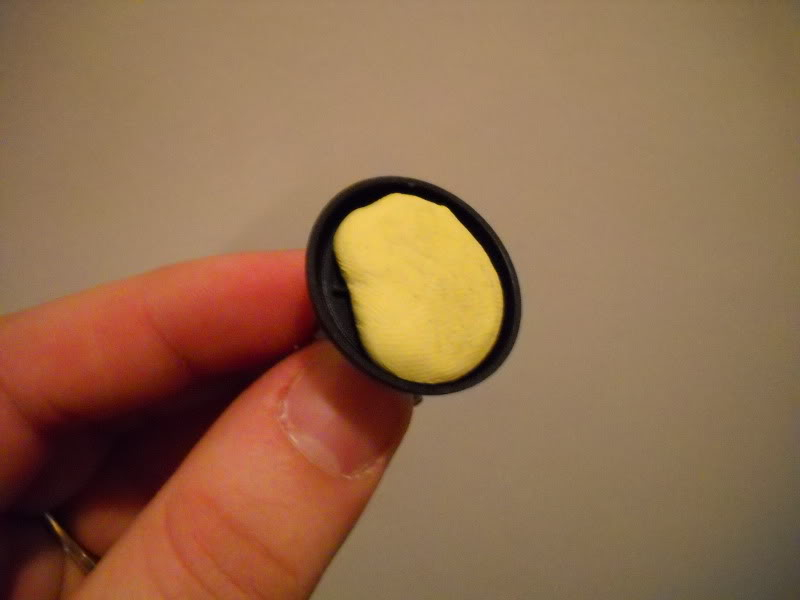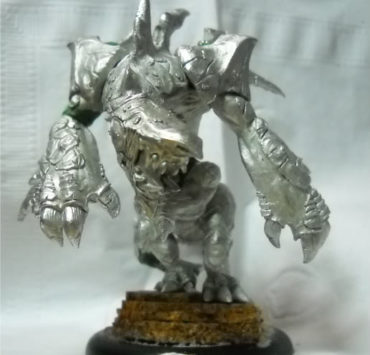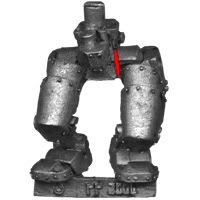Spray Paint Tutorial

Since the Paint Stripping tutorial was a success, here’s the next one. Spray Painting, or Priming models.
A primer is a preparatory coating put on materials before painting. Priming ensures better adhesion of paint to the surface, increases paint durability, and provides additional protection for the material being painted.
– Wikipedia
There are two questions that are asked frequently: What paint (brand) should I use? What color? I’ll do my best to address those as well as explain my spray painting process. It’s by no means THE way to do it, but it works for me. Your mileage may vary.
Choosing your Paint
First off, you’ll want an enamel spray paint. Acrylics dry superfast when not speeding through the air in tiny little droplets, so you can imagine why acrylics aren’t practical for spray paints. (They dry up before they even hit the model…) Enamels are the way to go. Make sure your can says “Enamel” on the front.
Flat paint only. Never, ever, ever, ever (ever) use gloss paint as a primer. (Ever.) Gloss paint is formulated to dry into the smoothest surface possible. That’s how it gets the shine. Gloss paint will not hold brush on paint well at all. Flat paint dries into a rough surface (on the molecular level), and since it has that roughness, brush on paint adheres pretty darn well. So long as you use a flat paint, GW, PP and other hobby paints should have no issue adhering and staying on the model. If you do have issues, it’s likely bad paint – bad primer or bad hobby paint.
Brands
My brand of choice is Testors. I have also had success with Krylon, but it tends to be more temperamental about the weather. I would discourage Rustoleum, since it’s mainly formulated for cars and outdoor applications. I would also discourage any house brands your local hobby store may have – I tried them once and it was horrible. Some folks swear by Krylon’s Sandable Primer. I’ve not used it, but that’s mainly because I prefer flat black, and I’ve only ever seen this in grey. The sandable primer is said to have the mildest of acids, so it etches itself into the surface, giving it a tremendous hold. I can only speak to what I’ve used. Testor’s is for me.
Nozzles
Testor’s uses a standard cone nozzle. The spray is fairly uniform, and if you were to shoot a wall without moving the can, you’ll get a circle. Krylon sometimes boasts a flat nozzle, so what you get is more like a line. If you shoot a wall, you’ll get an ellipse or oval shape. Both work fine, and the flat is in fact more forgiving. However, it does not cover as well because less paint is being applied.
Coverage
Coverage is the bastard child of paint formulation, nozzle shape and painter technique. Mess up any of the three, and you’ll have to do a second coat (or third). On the other hand, if one is bad, the other two can make up for it (often at the sacrifice of detail).
If the paint in the can is too diluted, it’ll go on thin, may not stick, and you’ll get bad coverage. You’ll know this is the case because it looks more like a wash – pooling into recesses and all the raised detail shows through the coat. This is fixed by doing two super light coats, paint slower (so more paint gets on the model, or by using a different can. Only the third option saves detail.
If the nozzle doesn’t put out enough paint, you’ll get a thin coat and the paint may not actually be able to smooth itself. By smooth itself, I mean that the droplets on the model mesh together (as a liquid), and flow into each other forming a uniform coat. If the droplets can’t reach each other (because there aren’t enough of them to bridge the gaps), no smoothing, it’ll feel like sandpaper. This is fixed by painting slower, so more paint gets on the model.
Misc
All spray paints work on all types of models. All brush-on paint should work just fine with all primers. Nothing is exclusive, and to my knowledge, no particular combination gives you the “best” results. Much like which paint line to use (GW, P3, Reaper, etc) your primer choice is up to personal taste and experiences. If you’re just starting out, give what I do a try. If it doesn’t work for you, start changing things one at a time until you get the results you want.
Color
The biggest factor in choosing a primer color is your scheme. Is your scheme bright, like Menoth’s studio scheme? Is it dark, like Cryx? Is it somewhere in the middle, with lights and darks? Are you using warm colors (red, orange, yellow, brass) or cold colors (blues, greens, purples, steel, brown).
Here’s my “rule of thumb” – If the scheme is mostly bright colors, go with white primer. Everything else, go black. If you really aren’t sure, get a can of each and do two test models. Whichever is easier / faster / looks best – that’s the primer for your scheme.
Alternatively, if your scheme is mostly one color, you could always use that color as your primer. Doing Khador? Pick up some flat red for example.
How to?
A step-by step…
- Make sure the models are clean. Dish soap and water before or after assembly will get rid of mold release (an oil used in manufacturing to ensure the parts slip from the mold easily).
- Find a place. It should be well ventilated (outdoors is best) and you don’t want anything you care about nearby – you don’t want to accidentally spray paint your car or pet. If you must be indoors, use a large box to contain the worst of the overspray and use an open window and fan. Breathe as little as possible.
- Be somewhere where the air is calm. Wind will move the paint around, and you’ll have a heck of a time getting it to hit the model.
- Humidity can be an issue. Too humid has never hurt me, but too dry and the air sucks the moisture out of the paint, and it lands dry. Then it won’t pool and your models feel like sandpaper.
- Prep the models. I prefer to do each model individually in its entirety before moving on. I use stick tac to adhere my models to old cans of spray paint:
- Shake the can well. 2+ minutes is sufficient. (I play a song on iTunes and shake for the entirety, which is usually 3+ minutes). If the paint feels like sandpaper when it dries, it could be that the paint and propellant weren’t mixed well enough. Shake it, baby!
- At about arms length, spray the model evenly.
- Start spraying on the left side of the model
- Move the spray over the model
- Stop spraying after the spray has left the model on the right
- Don’t touch the models for however it says on the can. My stuff says dry to the touch in about 12 minutes. I give ’em an hour or overnight. Better safe than sorry.
- Fix anything you missed with black (or white) brush-on paint. Invariably you’ll miss something. It’s not worth waiting half a day for spray paint to dry. Just use brush-on.
That’s the gist of it. I hope this has been helpful! Please post any comments or questions below or on the PP forum. I’m by no means an authority on this, but I’ll do my best to get you an answer promptly.
Thanks!




